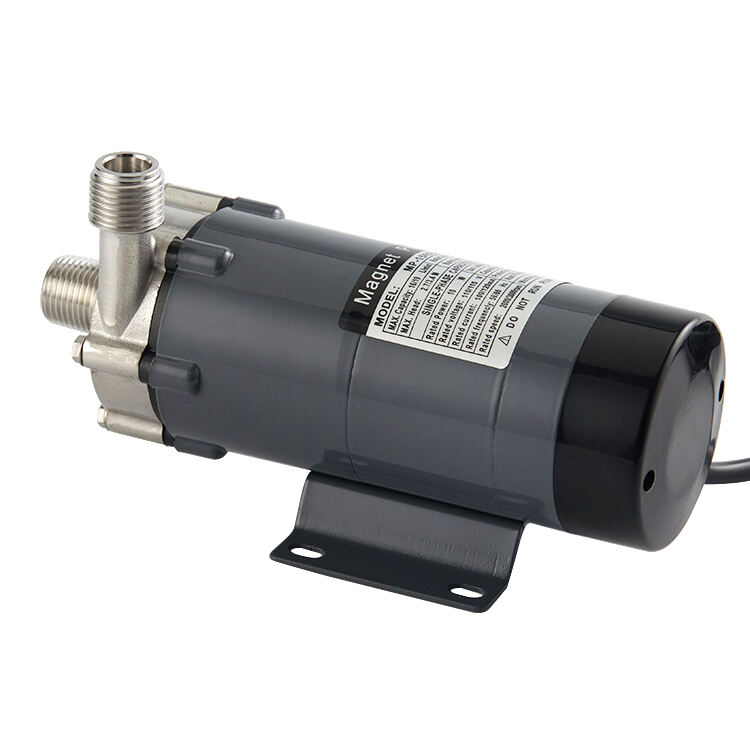Understanding Wort Transfer Technology in Modern Brewing
The heart of any efficient brewing system lies in its ability to transfer wort effectively throughout the brewing process. A wort pump serves as a crucial component in both home brewing setups and commercial operations, enabling brewers to move hot wort between vessels while maintaining temperature and minimizing oxidation. The choice between magnetic and electric variants can significantly impact your brewing experience, efficiency, and final product quality.
Modern brewing has evolved far beyond the traditional gravity-fed systems, with wort pumps becoming increasingly sophisticated and specialized. These essential tools help brewers maintain precise temperature control, ensure consistent flow rates, and protect the integrity of their carefully crafted wort throughout the brewing process.
Magnetic Wort Pump Technology
Core Components and Operation
Magnetic wort pumps utilize a sophisticated design where the impeller is driven by magnetic coupling rather than direct shaft connection. This innovative approach eliminates the need for shaft seals, significantly reducing the risk of contamination and maintenance requirements. The magnetic drive system consists of two sets of powerful magnets – one connected to the motor and another to the impeller – working in harmony to create smooth, efficient fluid transfer.
The sealed nature of magnetic pumps provides exceptional protection against leaks and contamination, making them particularly valuable for maintaining sanitary conditions during the brewing process. The absence of mechanical seals also means there are fewer wearing parts to maintain or replace over time.
Benefits and Limitations
Magnetic wort pumps excel in several key areas that make them attractive to both professional and home brewers. Their sealed design virtually eliminates the risk of oxygen exposure during transfer, helping preserve the quality of your brew. These pumps typically run quieter than their electric counterparts and generally require less maintenance due to their simplified construction.
However, magnetic pumps do have certain limitations. They tend to be more expensive initially, and their maximum flow rates might be lower compared to direct-drive electric pumps. Additionally, they can be more sensitive to running dry, which could potentially damage the magnetic coupling system.
Electric Wort Pump Characteristics
Mechanical Design Elements
Electric wort pumps feature a direct-drive system where the motor shaft connects directly to the impeller through a sealed housing. This traditional design has been refined over decades of brewing technology advancement, offering reliable performance and strong pumping capability. The direct mechanical connection provides immediate power transfer and typically allows for higher flow rates compared to magnetic alternatives.
These pumps often incorporate high-quality mechanical seals designed specifically for hot liquid transfer, ensuring durability and longevity even under demanding brewing conditions. The straightforward design makes troubleshooting and repairs relatively straightforward for those with basic mechanical knowledge.
Performance Considerations
Electric wort pumps generally provide superior flow rates and pressure capabilities, making them particularly suitable for larger brewing systems or situations requiring faster transfer speeds. They often offer more flexibility in terms of flow control and can handle a wider range of operating conditions without performance degradation.
The direct-drive design typically results in more efficient power transfer, potentially leading to lower energy consumption during operation. However, these benefits come with the trade-off of requiring more regular maintenance and the potential for seal wear over time.
Practical Application Considerations
Brewing System Integration
When selecting a wort pump, consider how it will integrate with your existing brewing setup. Magnetic pumps often excel in smaller, precision-focused systems where maintaining strict control over oxygen exposure is crucial. Their sanitary design makes them particularly valuable for brewers focused on delicate styles or those requiring extended aging periods.
Electric pumps typically integrate well with larger systems or those requiring frequent high-volume transfers. Their robust design and higher flow rates can help streamline the brewing process, particularly in commercial or semi-commercial settings where time efficiency is paramount.
Maintenance Requirements
Understanding the maintenance demands of each pump type is crucial for long-term brewing success. Magnetic pumps generally require less frequent maintenance, with most care focused on keeping the pump housing clean and preventing dry running. The absence of mechanical seals eliminates one of the most common points of wear in traditional pumps.
Electric wort pumps need more regular attention to maintain optimal performance. This includes periodic seal inspection and replacement, bearing maintenance, and careful monitoring of the shaft assembly. However, these maintenance tasks are typically straightforward and can often be performed by the brewer with basic tools.
Cost Analysis and Long-term Value
Initial Investment Considerations
The initial cost difference between magnetic and electric wort pumps can be substantial, with magnetic variants typically commanding a premium price. This higher upfront cost reflects their sophisticated design and specialized components. However, the investment often pays dividends in terms of reliability and reduced maintenance expenses over time.
Electric pumps generally offer a more affordable entry point, making them attractive for brewers working with limited budgets. The lower initial cost allows for easier entry into automated brewing systems, though long-term maintenance costs should be factored into the total ownership equation.
Operational Costs and Longevity
When evaluating long-term value, consider both operational costs and expected service life. Magnetic wort pumps typically consume less power during operation and require fewer replacement parts over their lifetime. Their sealed design often results in extended service life, particularly in well-maintained systems.
Electric pumps may incur higher maintenance costs due to regular seal replacement and potential mechanical wear. However, their simpler design often means repairs can be performed at lower cost, and replacement parts are generally more readily available and affordable.
Frequently Asked Questions
How often should I clean my wort pump?
A thorough cleaning should be performed after each brewing session, regardless of pump type. This involves running hot cleaning solution through the pump followed by a sanitizing rinse. For optimal performance, conduct a deep clean monthly or every 10-15 brewing sessions, paying special attention to impeller housing and seals.
Can I use the same pump for both hot and cold liquids?
Most quality wort pumps are designed to handle both hot and cold liquids, but it's essential to check the manufacturer's specifications. Magnetic pumps typically handle temperature variations better due to their sealed design, while electric pumps may require special consideration for seal compatibility with different temperatures.
What flow rate should I look for in a wort pump?
The ideal flow rate depends on your brewing system size and process requirements. For most home brewing applications, a pump capable of 5-8 gallons per minute is sufficient. Commercial operations typically require higher flow rates, often 10-15 gallons per minute or more. Consider your specific needs and system configuration when selecting flow rate capacity.

